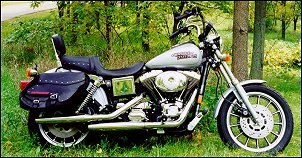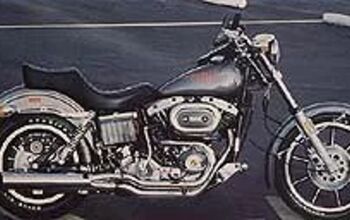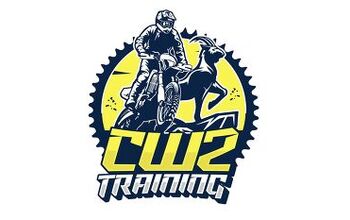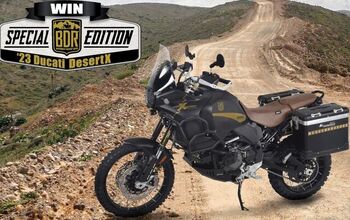Harley-Davidson FXDX-CONV Dyna Convertible - Motorcycle.com
CHICAGO, IL February 2, 1999 -- Back in 1971 a young Willie G. Davidson took the first of many cues from the custom builders of the times. He grafted a Sportster front end onto an FLH frame. The result was the Super Glide, the first FX. The 'F' stood for FLH, the 'X' for XLH. The idea was simple - add Sportster handling characteristics to a big twin. An idea that has been all but lost in today's landscape of super fat, super heavy, super wide cruisers.
Still, despite the "wider and lower is better" mantra of the 90's cruiser scene, the concept of a versatile cruiser, with great handling characteristics, still has fans at 3700 West Juneau Avenue. The Motor Company calls these bikes 'Dyna Glides' and the most versatile of all the Dyna's is the Dyna Convertible.
As its name suggests, the Convertible's claim to fame is its ability to change from a stripped-down boulevard cruiser to a back-road tourer.
It accomplishes this through the use of a quick release full-sized Lexan windshield and removable soft saddlebags. When stripped it is essentially a Dyna Low Rider. When dressed out it could be seen as the rough equivalent of a sporty Road King.
The optically-correct windshield is a bit of a grandma-quality accessory to some riders, but it is a godsend after a few days on the road or when the temperature drops much below 50°. We did however have a couple of sticking points with the wind blocker ...
A properly sized windshield allows the rider to see over it. while deflecting the wind over the rider's head. This windshield is tall enough for a 6'4" rider and cutting it down looks like no picnic.
Our second complaint is the antiquated mounting hardware. Four black plastic mounts attach to the upper forks and need to stay there looking ugly if you want the ability to quickly attach and detach the windshield.
When this attachment design came out in 1989 it was fine, but with the release of the slick "Detachables" line, it's starting to get long in the tooth. In other words, it's time to upgrade the Convertible's windshield to a Detachables model.
DETACHABLE BAGS
The detachable bags are made of tough, ballistic nylon. That makes them about as rugged as leather at a fraction of the weight. The bags open wide via a zipper that extends the complete length of both sides and the top. Being soft sided allows the bags to hold more than a rigid bag of the same dimensions, but also keeps them from being water proof.
To keep them out of the rear wheel, the back is constructed of hard plastic. Mounting a bag is accomplished by sliding it on two posts and then locking it down using a captured bolt. The whole business is dressed up with a decorative leather flap that buckles down to give the bags a more macho look.
With this snap missing the flap was exposed to the full force of the wind. Which caused the failure of a reinforcing plastic rib. The rib runs across the lowest portion of the flap to add rigidity and help it retain its shape. The rib broke right where the tie down strap crosses it. Two obvious improvements spring immediately to mind: Make the rib out of metal and create a stronger hold down mechanism. But six years into the model we find we are still stuck with this design flaw.
A BIG TWIN THAT HANDLES
There is much more to the FXDS than its bags and shield. The Convertible offers real world suspension numbers: 6.89" of travel in the front, 4.77" in the rear. Its 5.75" of ground clearance allows for respectable leans angles of 33.5° right and 34.5° left, easily the greatest of the Big Twins. Only a Sportster lets you hang it over further.
To add to its sporting stance, the forks are mounted at a 28° rake, tighter than even the agile Sportster Sport and allowing for surprisingly agile handling for such a large ride. Dual front disc brakes haul the bike down with authority (albeit with some effort on the rider's part).
Riding the back roads on the Convertible is a joy. The stiff Dyna chassis offers a tight connection between rider and road. The frame's fat, rectangular backbone does its job well not only creating a stiff bike but also one that is clean looking with only the frame's down tubes showing, leaving nothing but the Big Twin to look at. Isn't that the whole point of a cruiser?
While the rear shocks are nice and long, they are still classic H-D softies. As such they are more than willing to bottom out - especially when riding two-up. The same goes for the progressively wound front fork springs. They offer a nice Cadillac ride over most roads, but if the pot holes start coming at you or you try for a sudden stop, be prepared to dive. Harley's aversion to even slightly stiffer suspensions is hard to understand. No one is asking for ultra-stiff, superbike suspension on their Harley, but something along the lines of middle-of-the-road sport-tourer firmness would be nice.
One thing quite unsporting about this mount are the handlebars. Buckhorns, blek! These things put you in no position to actively attack any road, Or to stay comfortable for any length of time. You are part laid back, part leaning forward, part preying mantis. Holding yourself up against the wind is a hassle. Your hands are almost vertical and they are too low to create any leverage, not a good setup. We highly recommend swapping them out for a straight Sportster bar, or the Wide Glide's mini-ape hangers.
Handlebars aside, this Big Twin was made to ride. And this year the ride got even better. Much better. Eight cubic inches better.
THE FIRST CONVERTIBLE
The FX series went through several iterations before being christened "Dyna Glide," the last being the FXR family. The Eric Buell designed FXR started simple, but the line expanded dramatically, at one point boasting six different models, everything from a stripped down FXR Super Glide to the hard fairing/hard saddlebag tourer, FXRT Sport Glide.
Among these numerous models was the first Convertible, the 1989 FXRS Low Rider Convertible. Like the current Dyna Convertible, this model was billed as the do-it-all Harley.
The Convertible treatment was applied to the Dyna Glide chassis in 1994. In 1996 it got an updated frame, and of course the big news for 1999 is the Twin Cam 88 mill. Interestingly, the engine change did not warrant a tank logo change as the updated frame did ...
8 MORE CUBES AND LOTS MORE REVS
The first truly new Harley engine since 1936 is the big news for 1999, and the Convertible is one of the best showcases for the engine. Two-up spirited riding with loaded bags is a great way to put the engine through its paces and this engine more than met the challenge.
Meet the first stock Harley that is happy to cruise at 80 mph. Happy to pass an 18 wheeler doing 70 mph. This is a whole new kinda Big Twin for Harley.
Some of that change comes from eight more newly installed cubic inches, but most of it comes from the more square bore-to-stoke ratio. The mill specs out at 3.75" x 4". By comparison the 80 ci Evolution measured 3.5" x 4.25". This change results in a much more rev-friendly motor with only a minor loss in low-end grunt. The mid-range on the Dyna is now a wide open space in which the engine is very happy. Where the Evo loved 2000-3000rpm, the Fathead lives between 2500-3750rpm, creating an effortless city cruiser.
The Fathead gets its name from the wide air cooling fins covering it. Pictures really don't do it justice. You have to see one of these in person to really appreciate the increase in size. Harley tells us that the fin area has increased 50%. That means higher cooling capacity and more importantly, no need for water cooling.
The increased cooling ability was in evidence every time we rode her up in cold weather. This is one cold blooded engine. Even after coming up to temperature the engine demands some assistance from the enrichment knob. That is unless you like your bike sputtering out at each stop light.
We found that the fundamental feel of the Dyna Convertible is basically unchanged from last year. Its weight, balance and handling are all essentially the same. The clutch and tranny have the same identical feel. The big change is not so much in how the bike feels, but in how it makes you feel.
UNDER SQUARE ILLUSIONS The look of a Harley engine is as important as its performance. As such, the latest generation of the fabled Harley Big Twin demands comparisons with its predecessors.One such comparison is the long stroke look of the 45° V Twin. While the head design contributes to the tall look of an engine, the bore-to-stroke ratio is the main visual cue. So how do the five famous H-D big twins stack up?
As the table indicates, just by the numbers the Evo wins the tall engine competition. In addition to this its exposed push rod tubes are quite long and meet at a small cone-shaped cam cover -- creating the image of a narrow "waist." |
PASSING OF THE OLD GUARDAnother big improvement is in the area of vibration, which has almost dropped off the chart. This baby is smooth. So smooth in fact, that we think the only reason the Softails haven't debuted with the new engine is that the Harley engineers are busy trying to figure out how to add some vibration back. What good is a hard-mounted motor if it doesn't shake the rider?
The new Fathead also produces very little noise - either mechanical or exhaust. The Dyna Convertible we rode was almost dead quiet. The familiar pinging, clicking and other clatter of the Evolution engine is all but gone. And if you can imagine it, the exhaust note, while a bit lower in tone, is even quieter than last year. No need to trademark this sound. Then again that's what aftermarket exhaust pipes are for.
On that note, as true enthusiasts we must pause and recognize the passing of the old guard. With all the great gains that the Twin Cam 88 brings us, something has also been lost. As a rider you are now less aware of the machine. The experience has changed. No noise, no vibration, no oil spewing out on your leg....
A smooth, quiet engine is a good thing in most industries, but in the Harley world it is a mixed blessing. The Motor Company would have been fools not to move in this direction, but we know more than a few old school riders who will say that the magic ended in 1999. Then again they said that in '84 and probably back in '65.
LAST WORDS
The Dyna Convertible is easily the most functional and versatile bike that Harley-Davidson offers. But it doesn't take an expert to know that function is not what sells Harleys. Form sells Milwaukee iron and form is perhaps the Convertible's ultimate weakness.
In a sea of 32° racks, skinny 21-inch lace wheels and hidden rear suspensions, the sporty Convertible looks a bit tame. But just try to take one those chrome boats down a tight back road and you'll be holding up traffic like a camper in the mountains. It all depends upon what you want out of your ride.
More by Don Crafts

































Comments
Join the conversation